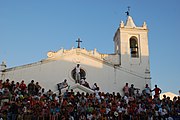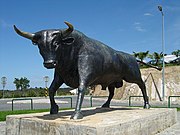Barrancos
Barrancos | |
|---|---|
 | |
|
UTC±00:00 (WET) | |
| • Summer (DST) | UTC+01:00 (WEST) |
| Local holiday | August 28 |
| Website | www |
Barrancos (Portuguese pronunciation:
The municipality is composed of one parish, being one of the six Portuguese municipalities composed of only one parish, and is located in Beja District, close to the Spanish border.
Among its economic activities are
The present Mayor is António Pica Tereno, elected by the Unitary Democratic Coalition.
The municipal holiday is August 28. Barrancos is famous in Portugal for its festival, which takes place each year during the last four days of August, and where traditional bullfighting occurs in the town's main square.
History
The territory where the Barrancos municipality stands today was initially conquered from the Moors in 1167, by Gonçalo Mendes da Maia, and the area's population was ordered by D. Sancho I in 1200. The original municipality was then located in the village of Noudar, which would only be definitively incorporated in the Kingdom of Portugal in the year 1295, when it was granted foral by D. Dinis. Noudar village was extinct in 1825, beginning a slow process of abandonment and migration to Barrancos.
Noudar, with its castle and old village ruins, is today one of the landmarks of the region. It is located 12 km to the northwest of Barrancos.
Language
In Barrancos, the Barranquenho language is spoken. Since 2021, this language is protected in the municipality.[4]
Notable people
- Paulo Guerra (born 1970 in Barrancos) a Portuguese former long-distance runner who specialized in the 10,000 metres and cross-country running
Gallery
-
Barrancos presunto
-
Barrancos parochial church
-
Castle of Noudar uphill
-
Monument to the bull
References
- ISBN 9781444393439.
I ah pesóah mái idoza de Barrancu, a mái belha falom quazi todah a ehpanhola, nãu falom barranquenhu. Agora é que ja bãu falandu barranquenhu. [...] And the most aged people in Barrancos, the oldest, they almost all speak Spanish, they don't speak Barranquenho. It's now that they are beginning to speak Barranquenho.
- ^ Instituto Nacional de Estatística
- ^ "Áreas das freguesias, concelhos, distritos e país". Archived from the original on 2018-11-05. Retrieved 2018-11-05.
- ^ Sousa, Guilhermina; Teles, Gonçalo (20 December 2021). "O barranquenho já tem proteção. Agora falta quem o ensine e quem o mantenha original" (in Portuguese). TSF.
External links




